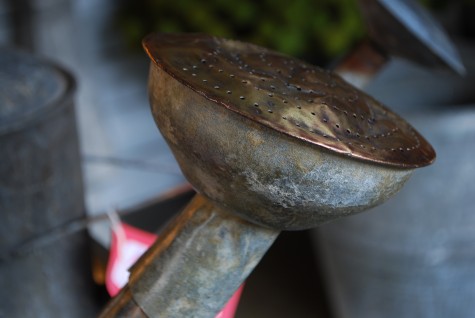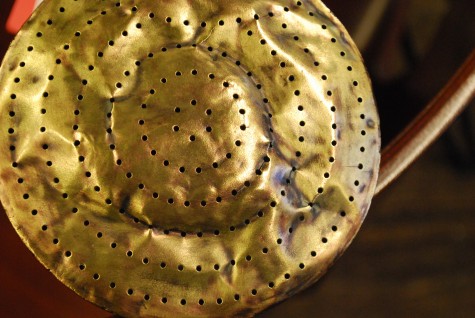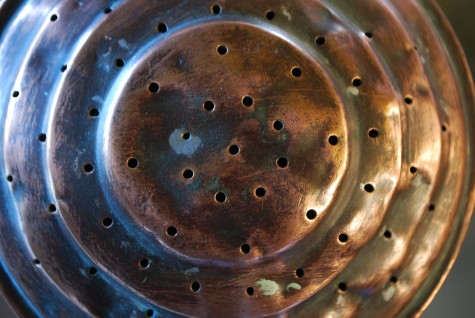At A Glance: The Rose
Watering Cans
 The word icon has broad and diverse meanings. I will not be discussing most of them, as I would be instantly over my head. But Rob’s collection of vintage watering cans which came off our container first up has me thinking about garden icons. The transport of water, via a vessel, from a source to a plant in need, defines the first watering cans. Known as watering pots, documentation exists from the 17th century.
The word icon has broad and diverse meanings. I will not be discussing most of them, as I would be instantly over my head. But Rob’s collection of vintage watering cans which came off our container first up has me thinking about garden icons. The transport of water, via a vessel, from a source to a plant in need, defines the first watering cans. Known as watering pots, documentation exists from the 17th century.
 All manner of designs shapes and sizes of watering cans came to be manufactured. I imagine very early vessels were made of sewn and waterproofed skins-I have no knowledge of the history-this is just my imagination talking. But later versions involved a holding tank, a spout, a handle, and a rose-forged in metal.
All manner of designs shapes and sizes of watering cans came to be manufactured. I imagine very early vessels were made of sewn and waterproofed skins-I have no knowledge of the history-this is just my imagination talking. But later versions involved a holding tank, a spout, a handle, and a rose-forged in metal.
 I have no love for watering with a watering cans. Any metal can that holds and transports enough water to do some good weighs a goodly amount empty. Should you not know, 2 gallons of water weighs 16.5 pounds. So add to the weight of the can to the weight of the water. Five gallons of water weighs somewhere in the neighborhood of 41.5 pounds. 41.5 pounds-this is how much Howard weighs. Would I want to carry him from the spigot across the deck and down the stairs to my planter box-no. No. What watering with a can involves in sheer weight-daunting. I vastly prefer a great and long hose. But the cans are a gardening icon-I would not think of doing without some.
I have no love for watering with a watering cans. Any metal can that holds and transports enough water to do some good weighs a goodly amount empty. Should you not know, 2 gallons of water weighs 16.5 pounds. So add to the weight of the can to the weight of the water. Five gallons of water weighs somewhere in the neighborhood of 41.5 pounds. 41.5 pounds-this is how much Howard weighs. Would I want to carry him from the spigot across the deck and down the stairs to my planter box-no. No. What watering with a can involves in sheer weight-daunting. I vastly prefer a great and long hose. But the cans are a gardening icon-I would not think of doing without some.
 This vintage can sports a handle at the top. If you have to carry a heavy load, the hnadle in this spot makes good sense. The handle at the back-a necessity once the work evolved from the carrying phase, to the pouring phase. This can needs a hand to carry, and a hand to defy gravity, and tip the spout down. Two hands on a tool brings a much greater level of precision to bear. When I try to handle a watering can with one hand, I either miss the mark entirely, or blast the plants out of the soil. But as much as I hate to carry water, I would have this can. It is a gardening icon. What better symbol for a gardener exists, as an invention designed to fit human hands that permits watering in a time of need.
This vintage can sports a handle at the top. If you have to carry a heavy load, the hnadle in this spot makes good sense. The handle at the back-a necessity once the work evolved from the carrying phase, to the pouring phase. This can needs a hand to carry, and a hand to defy gravity, and tip the spout down. Two hands on a tool brings a much greater level of precision to bear. When I try to handle a watering can with one hand, I either miss the mark entirely, or blast the plants out of the soil. But as much as I hate to carry water, I would have this can. It is a gardening icon. What better symbol for a gardener exists, as an invention designed to fit human hands that permits watering in a time of need.
 There are plenty and varied definitions of gardeners. Some fancy, some laborious, some silly-some miss the mark entirely. I cannot pass by a plant in need of water. This makes me a gardener. Do I water with a gardening can-not usually. But I do indeed have one-it is a symbol of my committment. I like my can, more for its iconography, more than its use.
There are plenty and varied definitions of gardeners. Some fancy, some laborious, some silly-some miss the mark entirely. I cannot pass by a plant in need of water. This makes me a gardener. Do I water with a gardening can-not usually. But I do indeed have one-it is a symbol of my committment. I like my can, more for its iconography, more than its use.

In the nineteenth century, the Haws watering cans moved the handles from the top, to the back. Thbis makes one-handed watering a distinct possibility, should you be really strong and able. That swooping handle may be eminently functional-but take a look -it looks beautifully graceful. A Haws can-this shape and volume implies moving a lot of water efficiently.
 These English vintage cans-each one has the dings and dents and out of round detail that documents their history. But they still hold water perfectly. The handle is an invitation to take hold. Put your hand confidently anywhere on this handle, and water away.
These English vintage cans-each one has the dings and dents and out of round detail that documents their history. But they still hold water perfectly. The handle is an invitation to take hold. Put your hand confidently anywhere on this handle, and water away.

Some cans-who knows what fluids they meant to disperse. This very beautiful can holds plenty; the short spout without a rose implies a delivery which is a torrent. Watering cans are usually outfitted with a rose. That rose converts a torrent to a sprinkle. No doubt, I would sprinkle my plants-not blast them out of the soil, given a choice. I will admit I have a collection of watering cans, none of which I use to carry water. If I fill one with water, the chances are good I will put cut flowers in it, and think about the garden.







